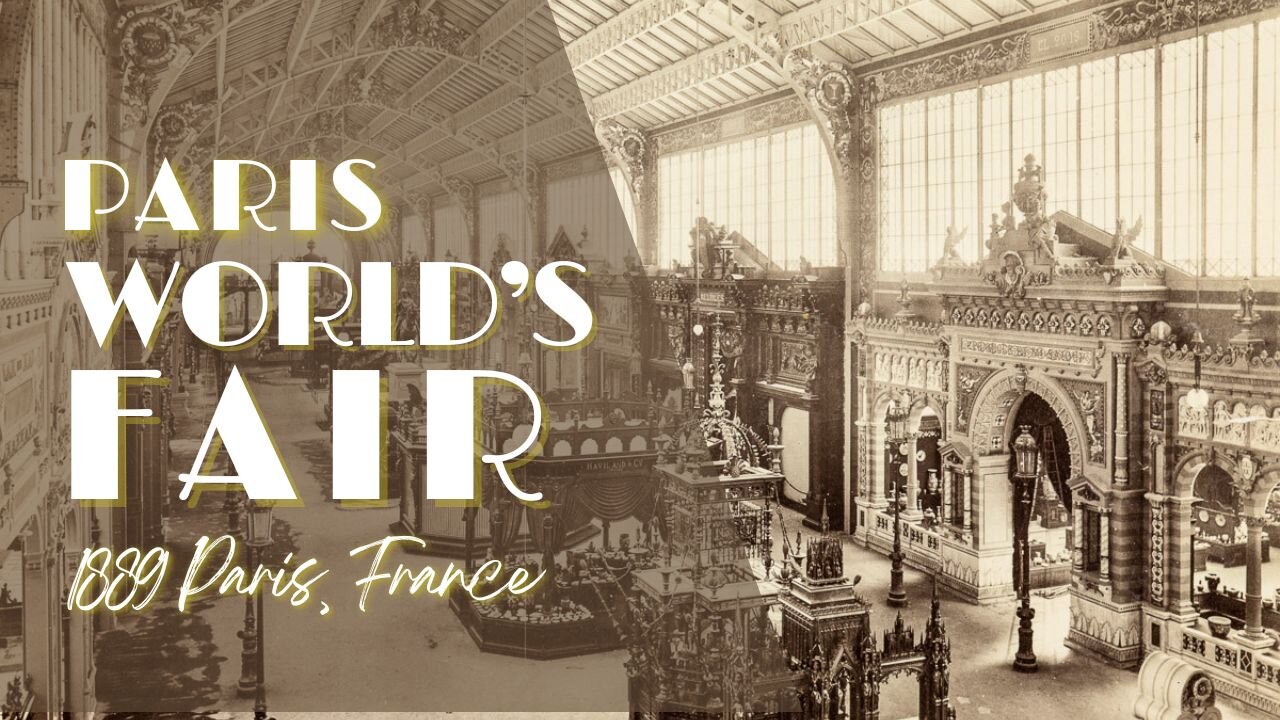Premium Only Content

Fantastical! 1889 Paris World's Fair Featuring New Technology
One Fantastical 1889 World's Fair in Paris Headlining Astounding Tech & Science | Edison, Otis elevators, Telephones, Electricity, Military tech, Navigation, The Eiffel Tower, Pre-fabricated metal housing...
The Universal Exposition of 1889 (Exposition Universelle de 1889) was a highly successful international exhibition and one of the few world's fairs to make a profit. Its central attraction was the Eiffel Tower, a 300-meter high marvel of iron by Gustave Eiffel. Over eighty other structures on the Champ de Mars housed exhibits, including the impressive 1,452 foot long Galerie des Machines by Ferdinand Dutert.
The fair attracted exhibits from Europe, South America, the United States, and the French colonies, yet in the final analysis it was a celebration of French achievements on the centennial of the French Revolution. Photographs in the Prints and Photographs Division document many of the achievements in architecture, the fine arts, and new technology that the exposition was designed to highlight.
1889 PARIS EXPOSITION
The Exposition Universelle of 1889, better known in English as the 1889 Paris Exposition, was a world's fair held in Paris, France, from 5 May to 31 October 1889. It was the fifth of ten major expositions held in the city between 1855 and 1937. It attracted more than thirty-two million visitors. The most famous structure created for the exposition, and still remaining, is the Eiffel Tower.
The exposition was held to celebrate the 100th anniversary of the Storming of the Bastille, which marked the beginning of French Revolution, and was also seen as a way to stimulate the economy and pull France out of an economic recession. The exposition attracted 61,722 official exhibitors, of whom twenty-five thousand were from outside of France.
Admission to the exposition cost forty centimes, at a time when the price of an "economy" plate of meat and vegetables in a Paris cafe was ten centimes. Visitors paid an additional price for several of the exposition's most popular attractions. Climbing the Eiffel Tower cost five Francs; admission to the popular panoramas, theaters and concerts was one franc. Visitors from the French provinces could buy a ticket which included the train fare and entry into the exposition. The total cost of exposition was 41,500,000 francs, while income was 49,500,000 francs. It was the last of the Paris world's fairs to make a profit.
THE EIFFEL TOWER
The Eiffel Tower, built especially for the exposition, was the tallest structure in the world at the time. A competition to build what was simply called "A tower of three hundred meters" with a base one hundred meters wide, was announced in 1886. It was won by the construction firm of Gustave Eiffel, which had recently built the iron frame of the Statue of Liberty. The Eiffel firm had advance knowledge of the project and, beginning in 1884, had already designed a tower exactly to those dimensions. The structural design was created by two Eiffel engineers, Maurice Koechlin and Émile Nouguier, who along with Eiffel himself, received the patent for the plan. An Eiffel architect, Stephen Sauvestre, designed the curving form and decoration which gave the tower its distinctive appearance. Eiffel was granted exclusive rights for twenty years to operate the tower and its restaurants and viewing platforms. A site next to the River was chosen, despite the infiltration of river water, since that land was owned by the City of Paris, and the tower could be kept in place after the exposition was completed.
The construction lasted two years, two months and five days, and involved five hundred workers, who assembled eighteen thousand iron pieces, each of five meters and carefully numbered, which had been made at a factory in Levallois-Perret, a Paris suburb. Speaking of the tower construction workers, the son-in-law of Eiffel, declared, "no soldier on the battle field deserved better mention than these humble toilers, who, will never go down in history." During the exposition, no one other than construction personnel were allowed higher than the second viewing platform.
THE GALLERY OF MACHINES
A second monumental building on the site was the Galerie des machines, by the architect Ferdinand Dutert and engineer Victor Contamin, which had originally been built for the 1878 Universal Exposition. It was a huge iron and glass structure which contained the industrial displays. It occupied the entire width of the exposition site, the land between the avenue de la Bourdonnais and the present avenue de Suffren, and covered 77,000 square meters, with 34,700 square meters of glass windows. At 111 meters, the Gallery covered the longest interior space in the world at the time, It cost 7,430,000 Francs, or seven times the cost of the Eiffel Tower. It was later used again at the 1900 Universal Exposition and then destroyed in 1910.
SCIENCE AND TECHNOLOGY
One important goal of the exposition was to present the latest in science and technology. Thomas Edison visited the exposition to visit a pavilion devoted to his recent inventions, including an improved phonograph with clearer sound quality.
Another new technology that was promoted at the exposition was the safety elevator, developed by a new American company, Otis Elevator. Otis built the elevators carrying passengers up the legs of the Eiffel Tower to the first level. When journalists expressed concern about the safety of the elevators, Otis technicians filled one elevator with three thousand kilograms of lead, simulating passengers, and then, with journalists from around the world watching, cut the cable with an axe. The elevator's fall was halted ten feet above the ground by the Otis safety brakes.
There were pavilions especially devoted to the telephone and to electricity, and others devoted to maritime navigation, and another, the Palais de Guerre or Palace of War, to developments in military technology, such as naval artillery.
Prefabricated metal housing was another technology that appeared at the exposition. Gustave Eiffel developed a series of houses with roof and walls of galvanized steel, and wooden interiors, which could be rapidly put together or taken apart, largely for use in French colony of Indochina. Some of them served as ticket booths at the 1889 exposition; one of these old booths, now used as a shelter for hikers, can now be found in the Forest of Dampierre.
MUSIC AND ENTERTAINMENT
The Barnum and Bailey Circus performed during the exposition in the Salle des Fetes of the Palais des Machines.
Outside the exposition, other theatres and venues presented a range of spectacles including Buffalo Bill Cody and his Wild West Show, with the sharpshooter Annie Oakley.
SOURCE
Lucius Aurelian
-
![The Man In The Red Cap Ushers In The Purification | Hopi Prophecy [Timestamp 16:35]](https://1a-1791.com/video/s8/1/E/k/O/v/EkOvv.0kob-small-The-Man-In-The-Red-Cap-Ushe.jpg) 26:46
26:46
The Aquarius Bus
6 months agoThe Man In The Red Cap Ushers In The Purification | Hopi Prophecy [Timestamp 16:35]
2.32K5 -
![[UPDATE 2.4] Hunt: Showdown | Sunday Solo Runs - #RumbleGaming](https://1a-1791.com/video/fww1/16/s8/1/J/A/L/V/JALVy.0kob-small-UPDATE-2.4-Hunt-Showdown-Su.jpg) LIVE
LIVE
LumpyPotatoX2
2 hours ago[UPDATE 2.4] Hunt: Showdown | Sunday Solo Runs - #RumbleGaming
437 watching -
 LIVE
LIVE
Amish Zaku
2 hours agoVariety Stream
98 watching -
 23:51
23:51
Adam Does Movies
20 hours ago $1.19 earned28 Years Later - Movie Review
6.97K3 -
 27:26
27:26
Scary Mysteries
1 day agoThe BUTCHER BAKER: Alaska's DEADLIEST Predator
4.12K -
 LIVE
LIVE
Gore TV
45 minutes agoBRAINS? Nah, Just Beans. ☕🧠🧟 ♂ | Coffee Break with Zombies!
79 watching -
 15:53
15:53
Forrest Galante
5 hours agoPrivate Tour of India’s Best Secret Aquarium
30.7K5 -
 LIVE
LIVE
Astral Doge Plays!
2 hours agoZelda: Breath of the Wild ~LIVE!~ Rito Times
68 watching -
 LIVE
LIVE
ABNERDAGREAT
3 hours ago🔴DOOM ON MARATHON ON RUMBLE🔴
26 watching -
 LIVE
LIVE
NEWSMAX
6 months agoNEWSMAX2 LIVE | Real News for Real People
1,688 watching